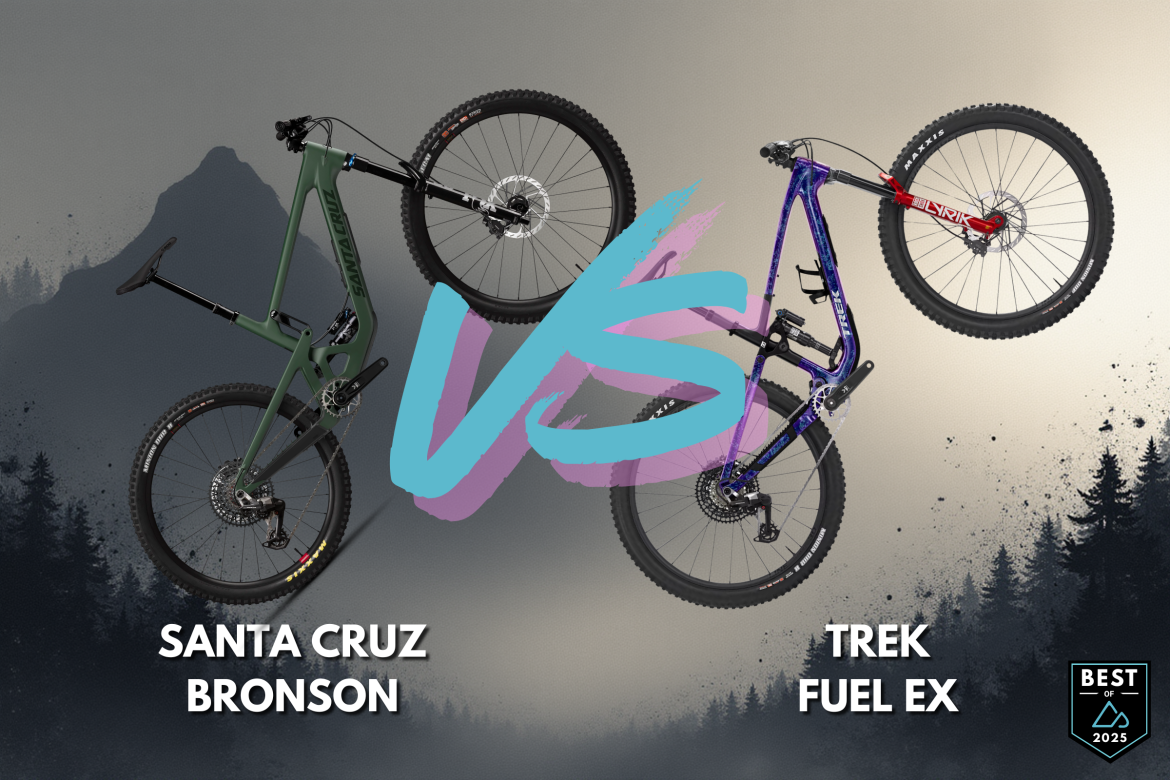
When comparing trail bikes, the conversation often centers on how much capability and adjustability you can pack into a single platform. The Santa Cruz Bronson 5 model year 2026 and Trek Fuel EX Gen 7 both answer that question, but their approaches diverge in meaningful ways. This comparison focuses on what matters most when choosing between these frames: geometry, suspension travel, adjustability, and frame features. Price and component spec are important too, so we’ve chosen two builds that are priced comparably for the chart below.
| Santa Cruz Bronson 5 MY26 Eagle 90 build | Trek Fuel EX 9.8 Gen 7 Eagle 90 build | |
|---|---|---|
| Suspension travel front/rear | 160/150mm | 150/145mm |
| Drivetrain | SRAM Eagle 90 T-type | SRAM Eagle 90 T-type |
| Suspension | Fox 36 Float Performance, Grip fork, Fox Float X Performance shock | RockShox Lyrik Ultimate fork, RockShox Deluxe Ultimate RC2T shock |
| Geometry (size large frame) | HTA*: 63.2° STA*: 77.3° Reach: 478mm Chainstay: 442mm | HTA: 64.5° STA: 77.4° Reach: 485mm Chainstay: 442mm |
| Weight | 34.14lb | 33.91lb (size medium) |
| Price | $6,099 | $5,999.99 |
Suspension travel and category positioning
The most significant difference between these bikes is their suspension travel and how each brand positions its platform for versatility.
The Santa Cruz Bronson runs 150mm of rear travel paired with a 160mm fork, which straddles the line between long-travel trail and light enduro. Santa Cruz achieves this with their VPP (Virtual Pivot Point) suspension design, delivering 150mm with a 230×57.5mm shock.
What makes the Bronson particularly interesting is its flip chip system in the lower shock mount. This adjusts the leverage ratio between two settings: a less progressive tune for a plusher feel on rugged trails with square-edge bumps, and a more progressive setting designed for hitting big features without bottoming out. This dual personality allows riders to tune the bike’s character significantly. The Bronson is compatible with coil shocks, though the Eagle 90 build here does not include one.
The Trek Fuel EX Gen 7 takes a fundamentally different approach to versatility. In its stock “EX” configuration, the bike runs 145mm of rear travel with a 150mm fork, giving it 5mm less rear travel and 10mm less up front compared to the Bronson. Trek uses its ABP (Active Braking Pivot) suspension design with a 205x60mm shock.
But here’s where things get interesting: Trek designed the Fuel platform to be three bikes in one. By swapping the alloy rocker link and lower shock mount, riders can convert their Fuel EX into a “Fuel MX” with 150mm rear travel and 160mm fork paired with mixed wheels (29″ front, 27.5″ rear). Or go full enduro with the “Fuel LX” configuration featuring 160mm rear travel and a 170mm fork. Like the Bronson, the Fuel EX also has a flip chip at the lower shock mount to adjust progression—handy for running a coil shock or fine-tuning the feel.
The trade-off? The Bronson comes ready to shred out of the box with more aggressive travel numbers, while the Fuel EX offers more theoretical versatility at the cost of needing to buy aftermarket parts to fully transform the bike. For some riders, the Bronson’s single-minded focus may actually be the simpler, more appealing option.

Geometry: Modern meets progressive
On paper, these bikes appear remarkably similar. But the details reveal real differences in how they’re designed to be ridden.
The mixed-wheel Santa Cruz Bronson features modern, aggressive geometry across its five-size range (S-XXL) designed to fit riders from 5’1″ to 6’7″ tall. The size large frame gets a 63.9° head tube angle in the low flip chip position (64.2° in high), a steep 78.2° seat tube angle (77.9° in high), 478mm reach, and 442mm chainstays. Santa Cruz uses size-specific chainstays that grow from 437mm on the small to 448mm on the XXL. The bike sits with a 344mm bottom bracket height in the high position or 341mm in low, depending on flip chip position.
Reach figures span from 432mm (small, lo position) to 525mm (XXL, hi position), and notably, Santa Cruz offers relatively small size gaps of about 20-25mm between sizes. The brand says standover height ranges from 721mm to 731mm across the size range, which isn’t a lot given the wide rider height spread.
The Trek Fuel EX Gen 7 runs similar but slightly different numbers. The size large delivers a 64.5° head tube angle, 77.4° effective seat tube angle, 485mm reach, and 442mm chainstays. Trek employs not just size-specific chainstays across its five sizes (SM-XXL), but also effective seat tube angles that vary based on frame size. Trek also offers five sizes, small through extra large, though the previous generation Fuel EX was offered in seven sizes.
Trek’s reaches start at 431mm for size small frames and grow to a full 530mm reach for size XXL frames. Stack heights have increased across the board on the Gen 7 compared to previous versions, and Trek now uses a straight seat tube for deeper dropper insertion. The Fuel EX sits at 339mm bottom bracket height (size large), which is lower than the Bronson.
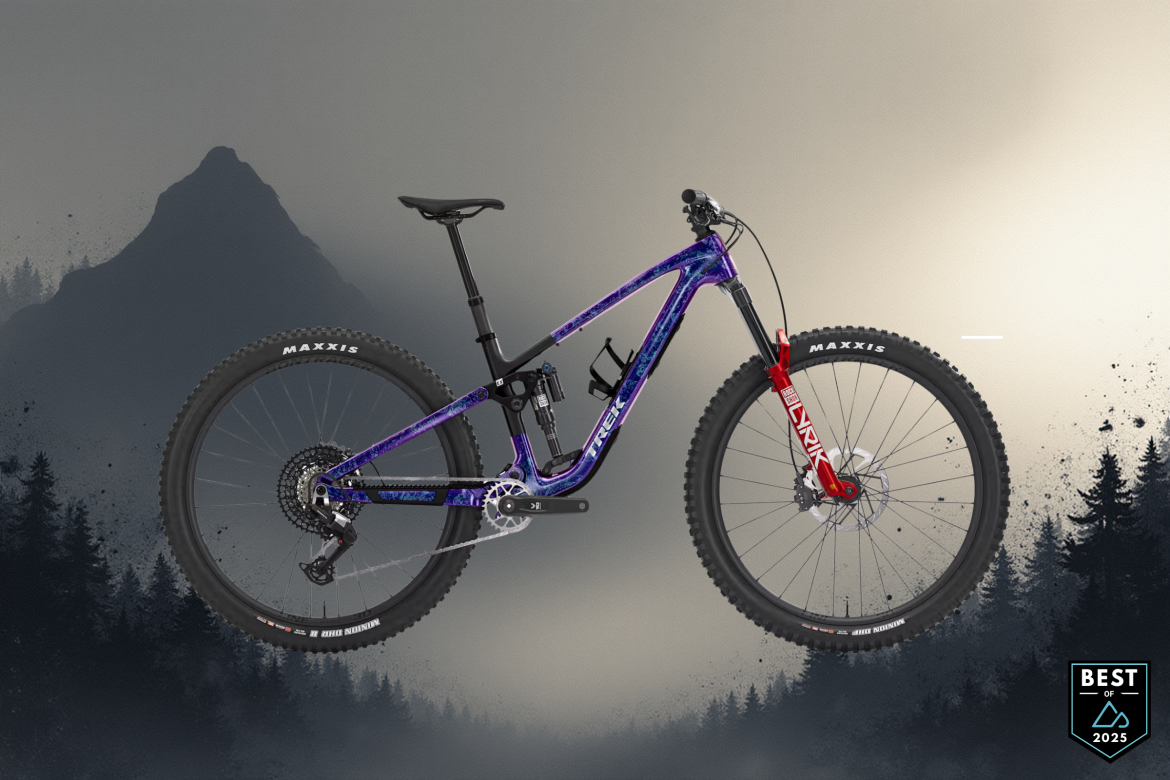
Adjustability: Flip chips and transformation
Both bikes embrace adjustability, but they do it differently.
The Bronson’s flip chip lives in the lower link pivot and offers two geometry positions. Flipping from low to high raises the bottom bracket by 3mm and steepens both the head tube angle (by 0.3 degrees) and seat tube angle (by 0.3 degrees). The chip also adjusts the leverage ratio, as mentioned earlier. This straightforward adjustment can be accomplished in minutes with basic tools. The Bronson is a dedicated mixed wheel bike, and the brand notes it is not designed to run matched 29er wheels.
The Trek Fuel EX’s adjustability goes deeper. The flip chip at the lower shock mount adjusts leverage ratio (less progressive for a plusher feel, more progressive for big hits or coil compatibility). But the real party trick is the interchangeable rocker link system. Trek sells separate $100 links that transform the bike between EX (150/145mm travel, 29″ wheels), MX (160/150mm, mixed wheels), and LX (170/160mm, 29″ wheels) configurations. In theory, this is brilliant. In practice, you’re buying aftermarket parts and changing fork air springs or shocks at a minimum, which requires a commitment. The upshot is that buyers might be able to get an extra season or two out of the bike as they progress.
Another thing to note about the Fuel EX is that size small bikes ship with a mixed wheel build, while the other sizes feature matched 29″ wheels. However, those larger sizes can be converted to mixed wheel down the line.
Frame features and construction
Both manufacturers have invested in well-executed frame features, though their approaches reflect different priorities.
The Santa Cruz Bronson uses Santa Cruz’s proprietary carbon layup with molded-in protection for the chainstay, seatstay, shuttle guard, and lower downtube. The frame includes the Glovebox internal downtube storage system with a new design for 2025.
Frame details include guided internal cable routing and a 73mm threaded bottom bracket (BSA standard), which are maintenance-friendly specifications. Santa Cruz offers a lifetime warranty on the frame and provides free replacement pivot bearings to the original owner for as long as they own the bike.
The Trek Fuel EX Gen 7 frame is available with OCLV Mountain Carbon and a more affordable Alpha NEXT Platinum aluminum. The carbon frame and shock weigh a claimed 3.31kg (7.3lb), while the aluminum frameset is significantly heavier at 4.95kg (10.92lb). Trek has updated the downtube storage for Gen 7 with a larger opening and tighter-fitting hatch, which the brand claims reduces movement and noise.
Like the Bronson, the Fuel EX uses a threaded 73mm bottom bracket and guided internal routing. The frame features molded protection for the seatstay, chainstay, shuttle guard, and lower downtube, plus a new ribbed chainstay protector to quiet drivetrain noise. Trek doesn’t offer lifetime bearing replacement, though the frame itself carries a lifetime warranty.
One notable difference: the Fuel EX’s aluminum option gives buyers a more affordable entry point to the platform, with builds starting at $2,899.99, while the Bronson is carbon-only, and complete bikes start at $5,149.
The bottom line
These are two excellent trail bikes that take different paths to versatility.
The Santa Cruz Bronson is the more aggressive option in its stock configuration. With 160/150mm of suspension travel, slightly slacker geometry, and premium carbon construction, the Bronson is a good choice for riders who prioritize descending capability and want a bike that’s dialed from day one. The threaded bottom bracket and free lifetime bearing replacement make long-term ownership appealing.
The Trek Fuel EX Gen 7 is the more versatile, transformation-focused option. Its modular design allows true platform flexibility as long as you’re willing to buy additional rocker links and potentially different shocks or forks. In stock EX trim, it’s a capable 150/145mm trail bike with slightly more neutral geometry than the Bronson. The availability of an aluminum frameset is a significant advantage for budget-conscious buyers, though the weight penalty is substantial.
Ultimately, your choice depends on how you define versatility. Want a bike that’s aggressive enough out of the box and simple to fine-tune? The Bronson delivers. Prefer a platform that can transform into a different bike in the future? The Fuel EX offers that flexibility. Both will handle demanding trail rides with confidence.












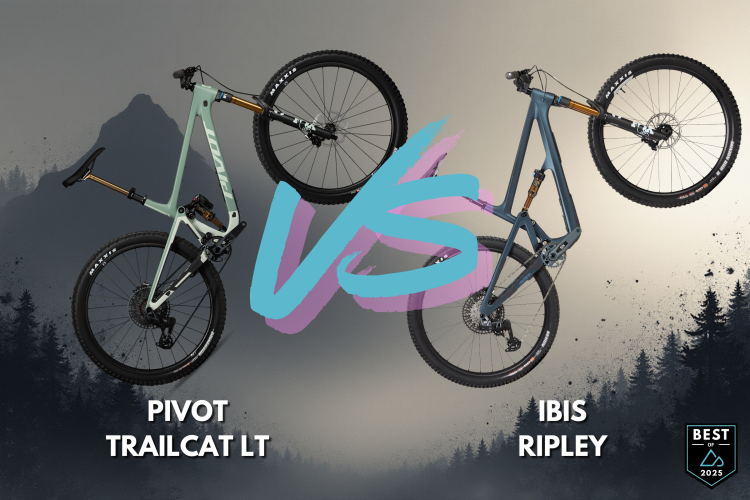
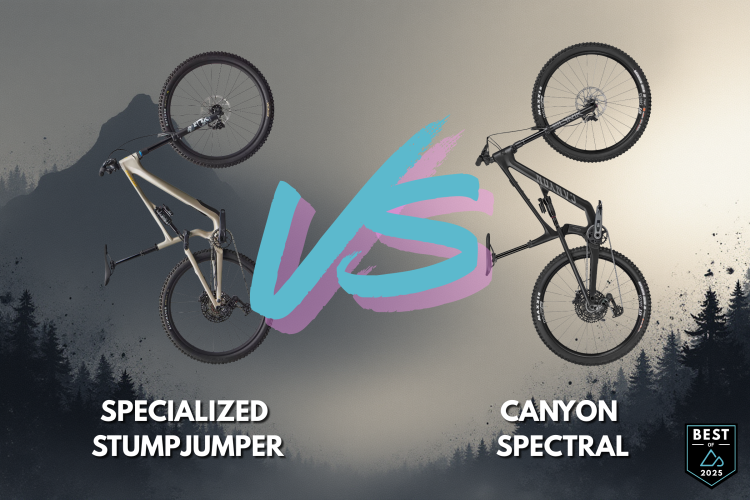



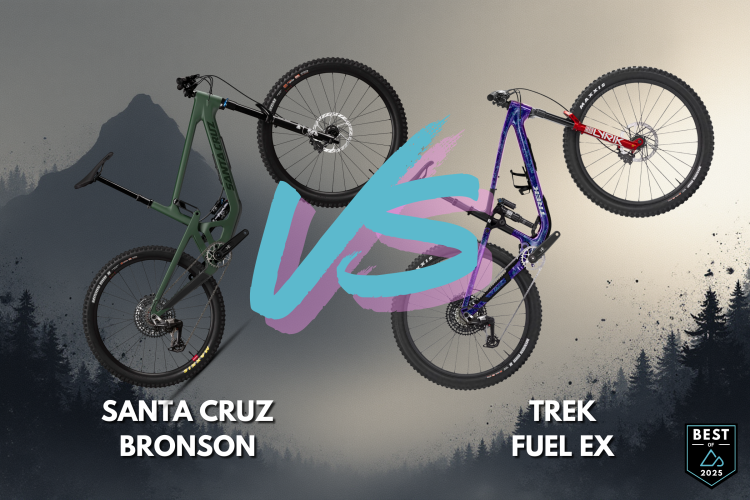

0 Comments